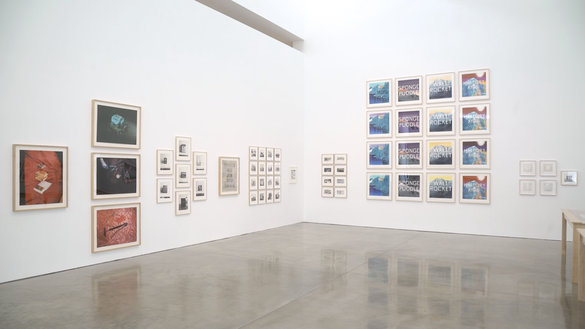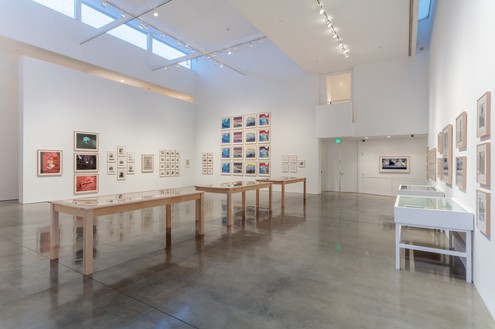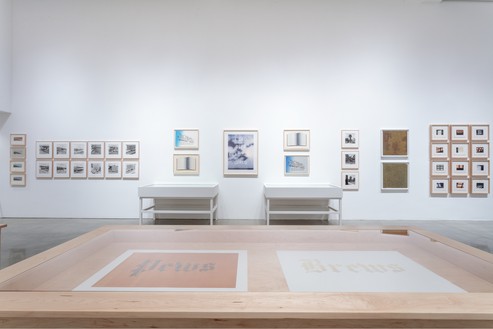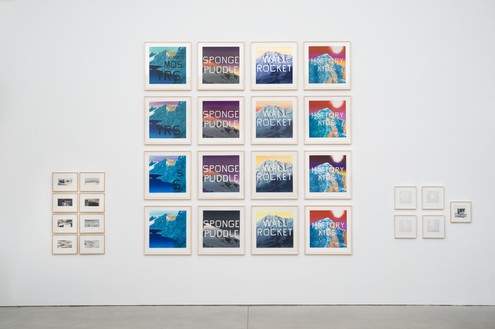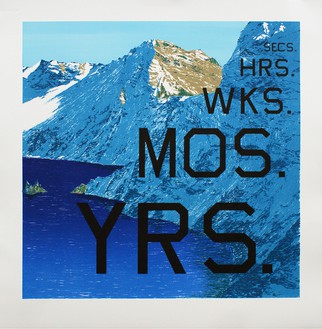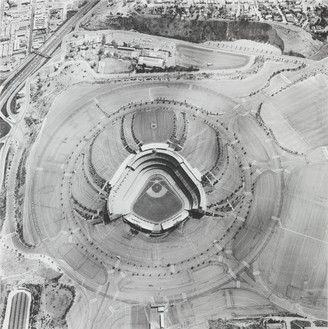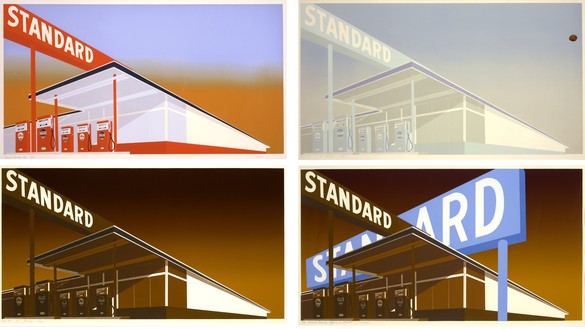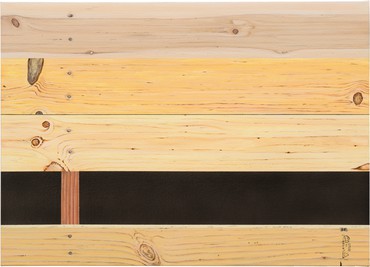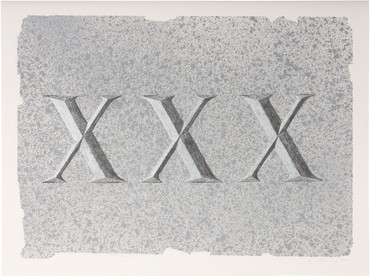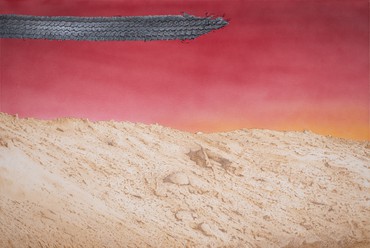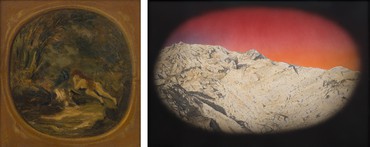About
Gagosian is pleased to present Ed Ruscha Prints and Photographs, a survey of Ruscha’s prints over forty years, together with rarely seen photographs produced since 1959. It is organized by Gagosian director Bob Monk and follows earlier iterations at Gagosian New York and Paris during the last two years. The exhibition will be presented in conjunction with Ed Ruscha Books & Co.
Ranging freely across materials both traditional and unconventional, Ruscha’s printmaking is a fluid forum for his spirited investigation of what a limited-edition artwork can be. Attracted to the reproducibility and happy accidents specific to the medium, Ruscha began making lithographic editions in the early 1960s, infusing the Pop and Conceptual sensibilities of the time with vernacular wit and melancholy. His exquisitely refined prints engage a breadth of formal themes, from text and typography to still life and quotidian architecture, played out in a spirit of rigorous yet restless experimentation.
The quartet of gas station prints—Standard Station, Mocha Standard, Cheese Mold Standard with Olive, and Double Standard (1966–69)—merges Euclidean space with Renaissance perspective and wordplay, while depictions of the Hollywood sign and its surrounding hills convey an attitude about the region’s landscape, at once scientific and romantic, natural and artificial. “‘Hollywood’ is like a verb to me,” Ruscha once commented. “It’s something you can do to any subject or anything.” His prints of the past four decades are random yet refined expressions of this unrestricted approach.
In the screenprint portfolio News, Mews, Pews, Brews, Stews, Dues (1970), rhyming words appear in Gothic type, printed in edible substances such as pie fillings, Bolognese sauce, caviar, and chocolate syrup. Each word alludes to Ruscha’s impressions of England: “News” symbolizes “a tabloid-minded country,” while “Stews,” made from baked beans, strawberries, chutney, and other foodstuffs, sums up British cooking. During the production of his second short film Miracle (1975), Ruscha used photography as the basis for prints for the first time: the incongruously titled Tropical Fish series of the same year presents banal tabletop still lifes against lustrous fabrics, from Air, Water, Fire—featuring a bicycle pump, seltzer bottle, and Satan statuette—to the chocolates, raw cuts, and bedsheets of Sweets, Meats, Sheets.
Share

Flags
Gillian Pistell writes on the loaded symbol of the American flag in the work of postwar and contemporary artists.

Donald Marron
Jacoba Urist profiles the legendary collector.
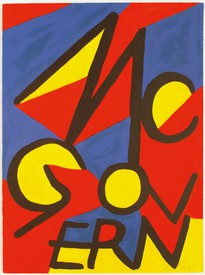
The Art History of Presidential Campaign Posters
Against the backdrop of the 2020 US presidential election, historian Hal Wert takes us through the artistic and political evolution of American campaign posters, from their origin in 1844 to the present. In an interview with Quarterly editor Gillian Jakab, Wert highlights an array of landmark posters and the artists who made them.
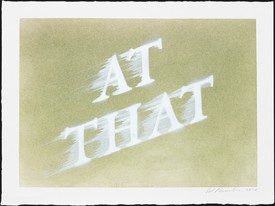
“Things Fall Apart”: Ed Ruscha’s Swiped Words
Lisa Turvey examines the range of effects conveyed by the blurred phrases in recent drawings by the artist, detailing the ways these words in motion evoke the experience of the current moment.

Artists’ Magazines
Gwen Allen recounts her discovery of cutting-edge artists’ magazines from the 1960s and 1970s and explores the roots and implications of these singular publications.
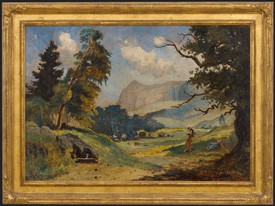
Eilshemius and Me: An Interview with Ed Ruscha
Ed Ruscha tells Viet-Nu Nguyen and Leta Grzan how he first encountered Louis Michel Eilshemius’s paintings, which of the artist’s aesthetic innovations captured his imagination, and how his own work relates to and differs from that of this “Neglected Marvel.”
News
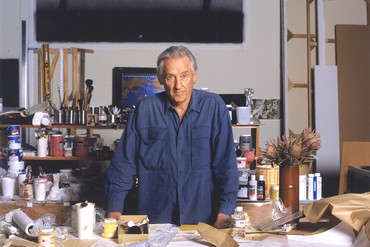
Artist Spotlight
Ed Ruscha
September 16–22, 2020
At the start of his artistic career, Ed Ruscha called himself an “abstract artist . . . who deals with subject matter.” Abandoning academic connotations that came to be associated with Abstract Expressionism, he looked instead to tropes of advertising and brought words—as form, symbol, and material—to the forefront of painting. Working in diverse media with humor and wit, he oscillates between sign and substance, locating the sublime in landscapes both natural and artificial. Ruscha’s formal experimentations and clever use of the American vernacular have evolved in form and meaning as technology alters the essence of human communication.
Photo: Kate Simon

galleryplatform.la
Ed Ruscha
Drum Skins
May 28–June 30, 2020
Gagosian is pleased to present recent paintings by Ed Ruscha online for galleryplatform.la. Fifty years ago, Ruscha purchased a set of vellum drum skins from a leather shop in Los Angeles. He has continued to collect these vintage objects, and since 2011 he has used them as canvases for the works on view in his solo exhibition Drum Skins at the Blanton Museum of Art at the University of Texas at Austin.
Installation view, Ed Ruscha: Drum Skins, Blanton Museum of Art, University of Texas at Austin, January 11–October 4, 2020. Artwork © Ed Ruscha
